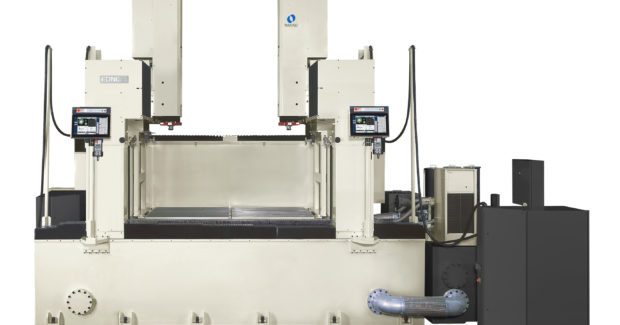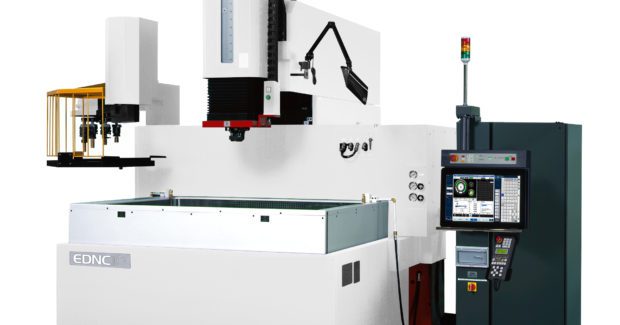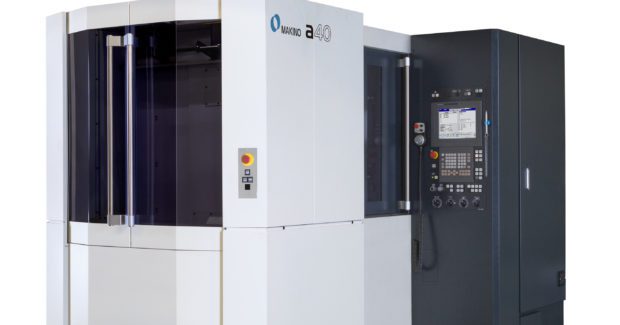Reduce Processing Time of Large Mold Tooling, Die Cast Parts
The dual-head configuration of the EDNC21 from Makino enables shops to process multiple fine details in a part at the same time, reducing total processing time at the same level of accuracy and surface finish as sinker EDMs one-tenth its size.
Posted: April 16, 2016
Makino Inc. (Mason, OH) introduces its EDNC21 sinker electrical discharge machine (EDM) with dual heads that provide an industry-changing advantage by improving productivity and lowering the tool build time for large molds. The EDNC21 also includes the latest EDM innovations and developments, including the Hyper-i control, HyperCut technology, and a new HS-Rib high speed Z-Axis. “As the design complexity of extra-large workpieces such as automotive bumper and fascia molds continues to grow, manufacturers must identify new means for processing a wider variety and volume of small intricate features with maximum throughput,” explained Brian Pfluger, the EDM product line manager at Makino. “The dual-head configuration of this machine enables shops to process multiple fine details in a workpiece at the same time, significantly reducing total processing time. Due to its rigid and precise construction, the EDNC21 is capable of achieving the same level of accuracy and surface finish as sinker EDM machines one-tenth its size.”
This sinker EDM offers a sizable work envelope of 122.0 in by 70.9 in by 39.4 in (3,100 mm by 1,800 mm by 1,000 mm) to accommodate extra-large workpieces, such as automotive bumper and fascia molds. The X-, Y- and Z-axes of the machine provide cumulative travels of 78.7 in, 59.1 in and 23.6 in (2,000 mm, 1,500 mm and 600 mm), respectively. Each of the gantry-style heads is capable of traveling up to 78.7 inches (2,000 mm) and is independently controlled and programmed using a dedicated Hyper-i control system for each head. The EDNC21 provides a total workpiece payload of 22,047 lbs. (10,000 kg) and accommodates electrode weights up to 662 lbs. (300 kg) per head. The design of the machine includes a programmable rise-and-fall front door for easy operator access during setup and operation. Door height, which controls dielectric fluid level, can be set to match the height of the workpiece while providing optimum viewing of the machining operation. Other features include:
- High-mass castings to ensure mechanical and thermal stability.
- Stationary table for accurate positioning regardless of workpiece size or weight.
- Space-saving integrated reservoir in the base casting to reduce machine size and to achieve greater thermal stability.
- Dual-anchored, direct-drive ballscrews that maintain precision long term.
The EDNC21 is designed with proprietary Hyper technologies that ensure an ideal mix of speed, finish, and reduced electrode wear. HyperCut technology is a new generator function that increases power levels without requiring additional reduction on the electrode, and it improves roughing speeds by up to 30 percent without affecting workpiece accuracy or surface quality. The technology minimizes electrode wear while providing the fastest possible machining speed.
Each EDNC-Series machine is equipped with the new Hyper-i control system that improves productivity by streamlining and simplifying the machine interface so that operators of all skill levels can achieve the most efficient results. Its 24 in high-definition monitor provides touch-screen technology similar to that of smartphones and tablets, enabling the use of pinch, swipe and spread movements to select machining conditions for workpiece and electrode material type, and the desired feature shape and surface finish. The user friendliness of the Hyper-i control is further enhanced with the integration of on-board digital manuals, intelligent E-Tech Doctor help functions, and an e-Learning training system. Additional performance enhancing technologies include:
- SuperSpark IV is an advanced adaptive control technology that optimizes the machining discharge power and electrode jump motions during roughing and finishing operations. This technology is especially effective on rib or drafted electrodes. When combined with HyperCut settings, it can reduce total machining time by up to 50 percent.
- All EDNC-Series sinker EDMs can be equipped with proprietary High-Quality Surface Finish™ (HQSF) technology that yields achievable surface finish capabilities 50 percent better than conventional surface finishes, regardless of discharge surface area. The HQSF technology can extend tool life through improved surface integrity, and can also reduce cycle time even when fine surface finishes are not required.
- High-Speed Z-Axis Option: The HS-Rib Z-axis configuration reduces rough machining speeds of small electrodes, such as plastic injection tooling ribs or pin gate details, and provides enhanced jump speeds of up to 20 m/min that can reduce machining times by up to 60 percent.
Makino has also expanded its lineup of EDNC-Series sinker EDM machines with the EDNC10, EDNC15 and EDNC20 that provide a powerful blend of power, speed and precision in large work envelopes. Each of these new EDNC sinker EDMs accommodate massive, heavy workpieces while still producing delicate, fine features with high accuracy and exceptional surface finish. The rigid and precise construction of the EDNC10, EDNC15 and EDNC20 can achieve the accuracy and surface finish levels found on smaller sinker EDM machines. “Many large-commodity sinker EDMs will see a significant performance drop-off in accuracy, surface finish and machine speed when compared to standard-size sinker EDM machines. These EDNC-Series machines overcome these challenges with key technologies that achieve small-sinker EDM performance on a large-platform machine,” noted Pfluger.
Automotive die and mold shops, aerospace and power-generation equipment manufacturers are sure to appreciate the larger work sizes of these machines. Specifications are noted below:
| Axis Travels (X, Y, Z) | Work Tank (W, D, H) | Max. Work Load | Max. Electrode Weight | |
| EDNC10 | 39.4 x 23.6 x 19.7 in
(1,000 x 600 x 500 mm) |
59.1 x 43.3 x 19.7 in
(1,500 x 1,100 x 500 mm) |
6,614 lb
(3,000 kg) |
662 lb
(300 kg) |
| EDNC15 | 59.1 x 27.6 x 19.7 in
(1,500 x 700 x 500 mm) |
98.4 x 55.1 x 31.5 in
(2,500 x 1,400 x 800 mm) |
22,047 lb
(10,000 kg) |
1,103 lb
(500 kg) |
| EDNC20 | 78.7 x 27.6 x 23.6 in
(2000 x 700 x 600 mm) |
110.2 x 63.0 x 41.3 in
(2,800 x 1,600 x 1,050 mm) |
22,047 lb
(10,000 kg) |
1,654 lb
(750 kg) |
The EDNC10, EDNC15 and EDNC20 feature 60 amp (80 Peak amps) power supplies as standard, with 120 amp or 240 amp options available. The EDNC10 and EDNC15 machines are designed with a full three-sided programmable drop tanks, providing unparalleled ergonomic access for setup and operation. The EDNC20 features a programmable rise and fall front door, which controls dielectric fluid level, and can be set to match the height of the workpiece while providing optimum viewing of the machining operation.
Makino also introduces its latest innovation in wire EDM technology, the U1310 wire EDM machine. Designed to substantially improve ease of operation, machining speed and accuracy in large workpiece applications, the U1310 delivers unmatched versatility and flexibility for a wide range of industries. “Too often, manufacturers assume that the larger the workpiece, the less precise the performance,” said Pfluger. “The U1310 debunks this myth by providing superior levels of precision even when compared to smaller travel EDM machines. With features like high-energy applied technology (H.E.A.T.) and an innovative fixed table design, operators can expect faster machining speeds on even the most difficult cutting applications and larger workpieces.”
The U1310 is available with H.E.A.T. configuration that incorporates a combination of flushing enhancements and special generator upgrades that greatly increase cutting speeds on the most difficult machining applications. H.E.A.T. technology is designed to provide unparalleled wire EDM machining speed and accuracy in parts featuring poor or difficult flushing conditions. This performance enhancement enables up to 43 percent faster machining times and up to 33 percent reduction in wire consumption, compared to previous technology.
The U1310 offers X-, Y- and Z-axis travels of 1310 mm by 1010 mm by 520 mm, and is optional with a larger full stroke 620 mm Z-Axis. The standard machine configuration can accommodate a maximum workpiece size of 2,000 mm by 1,600 mm by 500 mm and maximum workpiece weight of 6,000 kg. Other features of this wire EDM machine include a programmable 3-sided drop tank system for increased accessibility during workpiece loading and part setups, a fixed table for superior machining accuracy, and the intuitive Hyper-i control for improved operator efficiency and performance.
The U1310 is one of the world’s first large machines to feature a programmable 3-sided drop tank system, enabling excellent accessibility and easy setups for large workpieces and improving ergonomics for machine maintenance and operation. Operators can lower the work tank for unobstructed access from three sides, and can drop the tank below table level for even more accessibility. Additionally, since the work tank height can be adjusted to match the workpiece, the operator can clearly see the machining condition at all times. To reduce the operation interval for wire spool replacement, the machine is standard with a large capacity wire spool unit that accommodates spool size up to 30 kg.
The U1310 maintains superior machining accuracy with a fixed work table design that provides excellent machine rigidity, even when the table is loaded with a heavy workpiece. The combination of machine rigidity with machining technology and control software delivers exceptional roundness, and operators can expect shape accuracies within ±3 μm and a best surface finish of 0.3 μm Ra / 2.2 μm Rz. The machine is also capable of operating wire sizes of 0.200, 0.250, and 0.300mm diameter. Accuracy is also ensured by the U1310’s dielectric fluid cooling unit that is integrated into the base machine casting to keep the temperature inside the machine at the same level as the dielectric fluid temperature. This provides greater thermal stability, reducing distortion and ensuring stable high-machining accuracy even during long hours of machining.
Makino also introduces the a40, the first and only horizontal machining center purpose-built for non-ferrous die-cast parts machining. Until now, machine tool selection for the die cast market has been limited to general-purpose horizontals that possess unnecessary capabilities and result in extended cycle times in the machining of near net shape die cast parts. The a40 addresses the unique needs of the die cast market by enhancing machine attributes most critical to improving productivity and per-piece costs in the machining of near net shape die-cast aluminum parts.
“Die cast manufacturers are under intense pricing pressure with mandatory cost reductions from OEMs and increasing global competition. The keys to overcoming these challenges lie in the reduction of machining cycle time and elimination of unplanned down time,” said David Ward, the horizontal product line manager for Makino. “To address the cycle time issue, we have re-evaluated each of the major castings using an Intelligent R.O.I. (Reduction of Inertia) design philosophy. The new design provides superior linear and radial agility and acceleration.” Intelligent R.O.I. design is a collection of innovative technologies designed to slash un-productive non-cut times from part processes. Through this unique design strategy the a40 is able to provide:
- Responsive CAT40 spindle acceleration to 12,000 rpm in 0.5 seconds.
- Quick completion of common tapping operations with 6,000 rpm rigid tapping synchronization speed.
- An average of 29 percent faster time to full rapid traverse rate, minimizing common feature to feature positioning time.
- Optimal acceleration performance of multiple machine systems with evaluation of fixture and tool weights through Inertia Active Control (IAC) technology.
With the introduction of the a40, die cast shops now have a machine that is designed specifically with their production goals in mind. The machine’s ability to reduce part machining cycle time not only cuts down on per-piece cost, but also has far-reaching savings affecting capital investment, labor, floor space, utility consumption and durable tooling. The a40 offers a 400 mm pallet with a workpiece capacity of 630 mm (24.8 in) diameter by 900 mm (35.4 in) tall, making it an ideal platform for die cast parts commonly machined in the automotive and consumer product industries. Axis travels of the machine are 560 mm (22.0 inches), 640 mm (25.2 inches) and 640 mm (25.2 inches) in the X, Y and Z planes, respectively. Maximum payload is 400 kg (880 lb). The a40 also offers numerous features and capabilities for improved utilization and reductions in non-cut time, including a 40-position automatic tool changer and an automatic pallet change system to ensure uninterrupted operation.
Unplanned down time is devastating to high-volume die cast production machining. As such, the reliability of the machining system is paramount. The a40 utilizes several robust, proven systems like single-piece X- and Z-axis covers, center trough chip and coolant management, and dual supported ATC mechanisms that provide exceptional reliability throughout the life of the machine. The a40 leverages these proven technologies, but then advances reliability with a host of new systems:
- Standard Vision type broken tool detection supports unattended operation by quickly validating the condition of the cutting tools after each tool change.
- Dedicated tool taper cleaning nozzles wash the tool taper with 20μ filtered coolant with each tool change, ensuring contamination free tool clamping.
- Three stage coolant filtration with 20μ hydro-cyclone, eliminates coolant tank sludge common with aluminum machining, extending time between coolant system PM or cleaning.
For many die cast part manufacturing facilities, machining is a secondary capability that demands specialized labor skillsets and expertise. Machine shops seeking to maximize the productive benefits of the a40 can also turn to Makino for engineering support that maximizes the productive capabilities of their machine investment, including engineering and automation integration services.
Makino, Inc., 7680 Innovation Way, Mason, OH 45040-8003, 513-573-7200, Fax: 513-573-7360, [email protected], www.makino.com.


















